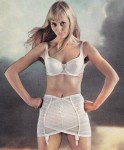July 29, 2015
Power-dressing through history

1980s female work suits. The monochrome palette & broad shoulders suggest seriousness and quasi masculine impact. Cleavage, heels and sleek hosiery hint at sexuality. A difficult balance to get right at work, even now.
“One day I was doing a signing in a London bookshop and next in the queue was a lady in what, back in the eighties, was called a ‘power suit’ despite its laughable lack of titanium armour and proton guns…”
– Terry Pratchett in Meditations on Middle Earth, 2001
Clothes convey power
Armour has its place as powerful outwear, and there are also the obvious signifiers of power, such as crowns, capes and military insignia. But everyday ‘civilian’ clothes have powerful messages of their own.
Sometimes this is through a literally enhanced presence: strong boots, built up shoulders, excess of fabric. Sometimes, instead of standing out, power is conferred by homogeneity – belonging to a group all wearing the same uniform. Perhaps a suit.
Historically, certain colours and fabrics have been jealously categorised as elite-only, and therefore power-enhancing: consider the colour purple, for example, or the Sumptuary Laws limiting silks to certain ranks.
Conceal or Reveal
How much of your body clothes cover is also significant. For example, are cultural requirements to hide the body, hair or face a form of gendered manipulation or a means of keeping power through modesty? Or, when clothes such as corsets, cages and contoured pads are used to mould the natural form into a fashionable shape, who has the power – the fashion industry, the consumer, or the spectator? As for etiquette, for much of human history, hats have played a crucial role in asserting power, or, when doffing a hat, offering homage to someone of higher status… or as an act of so-called chivalry.
Who’s Wearing the Trousers?

1983 office suit. Trousers for female leisure wear were worn by a few from the 1920s onwards; only by the 21st century were they fully ‘normal’ in all professional situations (except No. 1 dress in the military).
Trousers have very strong associations with power. The Romans disdained them as fit for barbarians (outsiders) only. 18th-century gentlemen at first scorned them in favour of breeches, then followed George ‘Beau’ Brummell’s example in wearing them. By the 19th century they were firmly established as a fundamental garment for men. To wear trousers meant having freedom-of-movement, as well as the symbolic power of patriarchy. No wonder women had to fight so hard to wear them, enduring ridicule in the 1860s with Turkish trousers, then wary admiration for cycling breeches in the 1890s, and finally a long, slow integration of trousers into everyday wear. We might ask – is there ‘power’ still in skirts and dresses? For Transgender people, how might the power dynamic change when adopting clothes weighted with such assumptions about gender?

Are seductive clothes a passive form of power-dressing? Here, an elasticated nylon girdle and under-wired bra from 1967
Leaving the Past Behind?
Many of our clothing choices are still based on cultural constructs from history. In an era of fast fashion, ‘designer’ labels and creeping informality how, if at all, do we show power now?
Lucy Adlington @historywardrobe is author of Great War Fashion; also Fashion:Women in World War One, and the forthcoming book from Penguin Random House, Stitches In Time, the Story of the Clothes we Wear
She runs History Wardrobe – delightful costume-in-context presentations – and lectures extensively in the UK
Join the #csfashionhour discussion 2pm September 4th 2015

